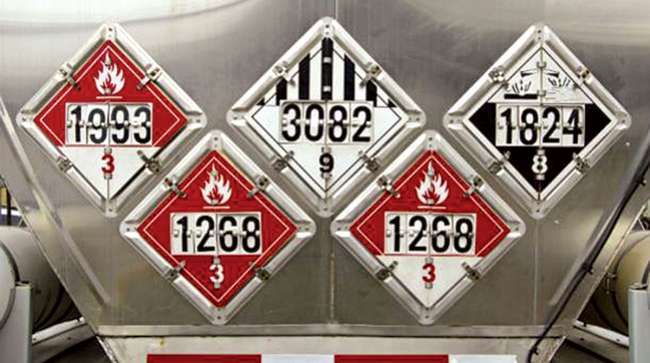Senior Reporter
Audit Says Hazmat Regulators Need to Meet Timely Reviews of Carriers

[Stay on top of transportation news: Get TTNews in your inbox.]
Hazardous materials regulators are falling short in performing some required timely reviews of whether hazmat carriers have the “knowledge, capability and performance record” to safely move hazmat, according to a new Department of Transportation inspector general audit.
“The Pipeline and Hazardous Materials Administration is improving its three-tier hazmat fitness review processes, but its timeliness goal is not always achievable,” said the audit, made public in late March.
“Specifically, PHMSA processed most Tier 1 reviews within DOT’s 120-day goal but took longer for tiers 2 and 3. PHMSA investigators did meet agency standards for inspecting and developing fitness memorandums.”
PHMSA Hazmat Fitness Review... by Transport Topics
The audit said PHMSA’s oversight of hazmat fitness reviews for approval and special permit applications includes a three-tier process to determine if an applicant’s fitness supports the safe commercial transportation of hazmat. Federal law requires DOT to inform the public when applications for PHMSA approvals and special permits take more than 120 days to process, explain why the review is delayed and estimate a completion date.
Dan Horvath, vice president of safety policy for American Trucking Associations, said that ATA maintains a close relationship with regulators at PHMSA, “including input from our motor carrier members on how certain processes can be improved.”
“What I’m aware of is that the audit revealed that PHMSA was behind in getting certain processes done in a timely manner,” Horvath said. But he noted that ATA has seen some process changes at PHMSA in recent months and years, and an overall attempt to improve the availability of information within its website.
He said the Federal Motor Carrier Safety Administration works closely with PHMSA, but FMCSA actually gives fitness determinations of motor carriers for safety, and also enforces PHMSA regulations.

Horvath
Horvath added, “As far as special permits, that’s all done through PHMSA. So depending on what hazmat you are transporting, you may need to obtain a special permit — which is issued and reviewed through PHMSA.”
The agency’s Tier 1 automated report contains hazmat-related incidents, enforcement actions and inspection results, and uses six objective questions to calculate whether applicants meet PHMSA’s minimum level of fitness criteria. If an applicant fails the Tier 1 review, a project officer forwards the application to the agency’s Field Services Support Division for a Tier 2 safety profile evaluation.
During a Tier 3 on-site inspection, the agency’s regional office investigators visit and evaluate applicants’ overall facility operations and determine their ability to perform the tasks identified in their applications, as well as matters such as training and security policies.
After completion of the audit the inspector general forwarded 12 recommendations to PHMSA, none of which the agency disputed.
DOT developed the hazardous materials regulations for the safe and secure transportation of hazmat in commerce and to oversee whether shippers, carriers and others are complying with packaging and transportation safety standards outlined in the regulations, the IG report said. The regulations require that applicants apply for and receive PHMSA approval before performing certain functions, such as re-qualifying propane tanks that meet DOT specifications, or obtaining a special permit to perform functions prohibited by the regulations.
Other findings of the agency audit showed:
- The agency reviewed the fitness of about half of the Tier 1 applicants within 120 days, but corrected a weakness in the process regarding registration approvals
- Guidelines on referring applicants for Tier 2 evaluations are unclear in certain areas
- The agency did not document its decision-making process for managing Tier 3 inspections
- The field operations manual does not fully explain the use of quality control or risk assessments
According to PHMSA data, more than 3.3 billion tons of hazardous materials — valued at more than $1.9 trillion — are transported by air, highway, rail and sea vessel in the United States each year. In calendar year 2019, about 22,300 hazmat incidents occurred in all modes of transportation nationwide, resulting in 7 fatalities, 177 injuries and approximately $91 million in damages, “demonstrating the importance of robust oversight of all hazmat transportation,” PHMSA said.
Additionally, PHMSA has an interagency agreement with FMCSA, the Federal Railroad Administration, Federal Aviation Administration and U.S. Coast Guard, providing a framework for governance and operational work flow for special permits and approvals.
Want more news? Listen to today's daily briefing above or go here for more info
The interagency agreement states that DOT’s goal is to complete the entire application review process — including automated reviews in Tier 1, safety profile evaluations in Tier 2 and on-site inspections in Tier 3 — within 120 days. PHMSA strives to continually improve its processes to meet the challenges of safely transporting hazardous materials. The 120-day goal is meant to ensure that “PHMSA does not impede the movement of hazardous materials that are essential to everyday life,” the agency said in a statement to Transport Topics. “PHMSA receives thousands of hazmat and special permit applications each year. Most of these applications are processed and accepted within the 120-day window.”
Of the few applications that are not accepted within the 120-day period, many are foreign manufacturers, which can take longer to process.
“The COVID-19 public health emergency has also led to new challenges, but PHMSA is working to address these issues,” the agency said.



